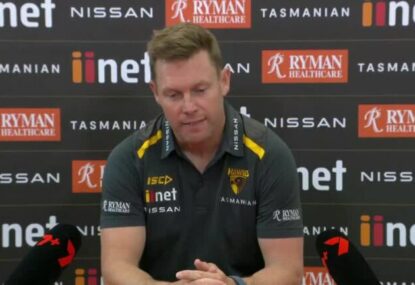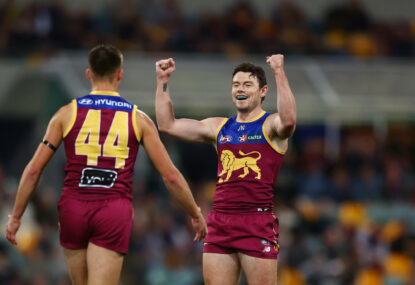After becoming the first side since the Adelaide Crows in 1999 to miss the finals one year after winning the premiership, Hawthorn entered the 2010 decade looking to prove that their triumph against the Cats in 2008 wasn’t just a flash in the pan.
Entering Alastair Clarkson’s sixth season in charge, the Hawks looked incredibly shaky at 1-6 in 14th spot on the ladder. But with 11 wins from their next 15 matches, Hawthorn stormed into September, heading west to face Fremantle in an elimination final. They were easily brushed aside by the Dockers, responding with a superb 2011 campaign in which they lost just four matches on their way to a top-four finish. In a heavyweight preliminary final battle with the reigning premiers Collingwood, Hawthorn were bested by a late Luke Ball goal, ending any hope the Hawks had of meeting the Cats in another grand final.
The 2012 season would be another strong year for Hawthorn, finishing on top of the ladder for the first time since 1989. After surviving a scare in the preliminary final against Adelaide, the Hawks reached the grand final for the 16th time in their history. Matched up against the Sydney Swans, the two sides played an all-time classic, with Hawthorn falling short by ten points. A year later, and another top spot finish for the Hawks. After a heart-stopping win over Geelong in the preliminary final, Hawthorn met Fremantle in the premiership decider. Driven by their heartache a year earlier, the Hawks won flag number 11 with a gritty 15-point victory.
The Hawks were dealt a massive blow immediately following their triumph over the Dockers, with star goal-kicker Lance Franklin leaving the club as a free agent. Looking to avoid another premiership hangover, Hawthorn didn’t let Buddy’s departure affect them, narrowly missing out on another first-placed finish on the ladder. Once again, the Hawks had a heart-stopping preliminary final, this time against Port Adelaide, as they qualified for a third consecutive grand final. Matched up against the Swans, the same side that bested them in 2012 and the team that Franklin defected to, Hawthorn exacted some revenge with a 63-point belting.
Clearly the team to beat after two premierships in a row, the Hawks were on a quest to go back-to-back-to-back for the first time in club history in 2015. With 16 wins for the year, the Hawks managed to finish third on the ladder, heading across the country to play West Coast in their first final. After a disappointing loss, Hawthorn won through to the penultimate weekend of the season, but were again forced to go across the Nullarbor to play Fremantle. Against the odds, the Hawks claimed a famous victory, winning through to yet another grand final, where they would once again meet the Eagles. In a withering first half, Hawthorn blew West Coast away with a 46-point victory, becoming the first side since the Brisbane Lions in the early 2000s to win three consecutive flags.
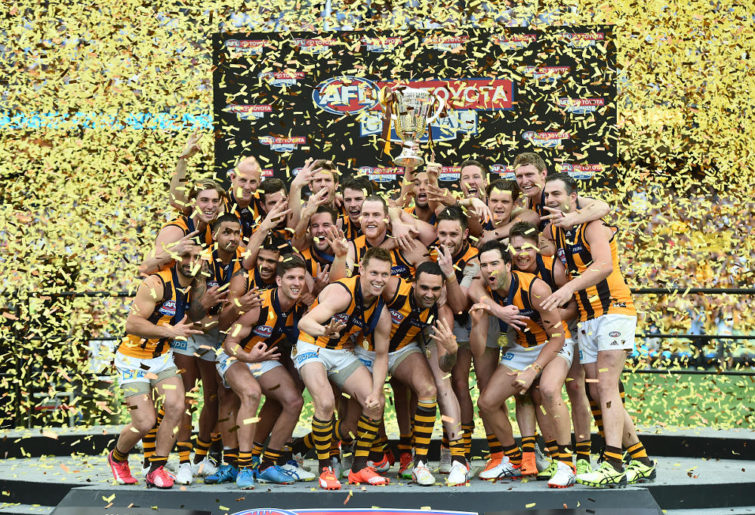
(AAP Image/Julian Smith)
Faced with the enormous task of becoming the first side since the famous Collingwood outfit of the 1920s to win four premierships in a row, the Hawks managed a sixth consecutive top-four finish. In a pulsating qualifying final against Geelong, the Hawks would just fall short of earning a much-needed week off after Isaac Smith missed a goal after the siren. Taking on a vibrant and in-form Western Bulldogs side in the semi-finals, Hawthorn were overrun, signalling a changing of the guard as Alastair Clarkson’s men were sent out of the finals in straight sets.
With a number of their senior players departing the club, Hawthorn struggled in season 2017, missing the finals for the first time in eight years. It appeared a similar fate would fall upon the Hawks in 2018, with the team sitting outside of the top eight heading into Round 18. However, with six consecutive wins to end the season, Hawthorn finished in fourth position, qualifying for the double chance. However, similarly to 2016, the Hawks failed to make a splash in September, losing their opening two games to fall out of the premiership race. The Hawks would be competitive again in 2019 but fell just one game short of making another finals campaign.
Best wins
Preliminary final, 2013 – Hawthorn 14.18.102 beat Geelong 15.7.97 (MCG)
Following a surprise win over the Cats in the 2008 grand final, Hawthorn routinely struggled when they came up against Geelong, losing a number of close matches against their fierce rivals. Dubbed the Kennett Curse, Hawthorn would come face-to-face with the monkey on their back when they reached the preliminary final in 2013. Taking on a Geelong side that had notched up 11 straight victories against the Hawks, it appeared the curse got the better of Hawthorn yet again when they trailed by 19 points early in the final quarter. However, with the final three goals of the match, the Hawks got their noses ahead. A late miss at goal from Geelong’s Travis Varcoe sent Hawthorn through to a second consecutive grand final, ending the Kennett Curse once and for all. Since then, Hawthorn have a 7-6 record over the Cats.
Grand final, 2014 – Hawthorn 21.11.137 beat Sydney 11.8.74 (MCG)
Taking on the same team that upset them on the same stage in 2012, Hawthorn had a bone to pick with the Swans, especially as they were coming up against Lance Franklin – the man who helped the Hawks to two premierships in his time in the brown and gold. In Franklin’s first year at Sydney after departing the Hawks as a free agent, he took the Swans to the minor premiership as he won his third Coleman Medal. Outsiders to win a second premiership in succession, Hawthorn raced to a game-winning seven-goal lead at halftime, quickly distancing themselves from the struggling Swans. The Hawks would finish with the second highest score in a grand final since 1996, with captain Luke Hodge becoming just the third player in VFL/AFL history at the time to win two Norm Smith Medals.
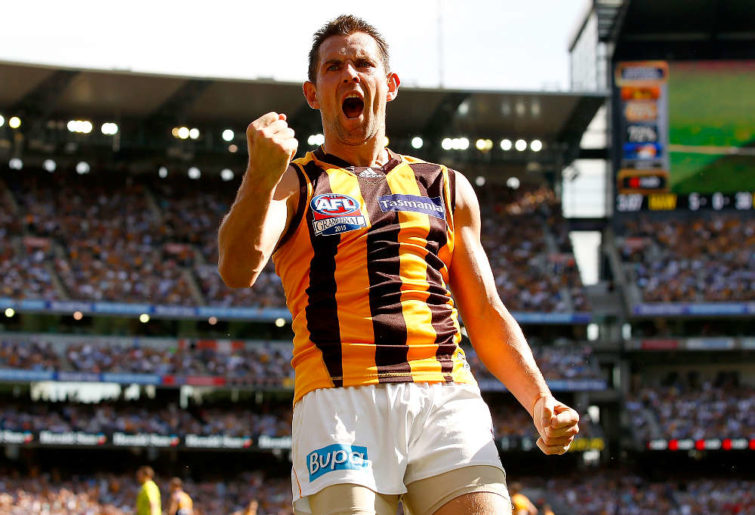
(Photo by Justine Walker/AFL Media)
Preliminary final, 2015 – Hawthorn 15.4.94 beat Fremantle 10.7.67 (Subiaco)
Heading across to Western Australia for the second time in three weeks, Hawthorn had their backs up against the wall as they looked to win through to their fourth grand final in a row. After a dismal performance a fortnight earlier against West Coast, the Hawks took on the minor premiers Fremantle at their Subiaco fortress. In a tight match, Hawthorn used their experience and guile to claim a 27-point win. They would go on to easily brush the Eagles aside in the big dance, winning back-to-back-to-back flags.
Worst losses
Preliminary final, 2011 – Collingwood 10.8.68 beat Hawthorn 9.11.65 (MCG)
When it comes to heartbreaking losses in finals, Hawthorn fans have been blessed in recent years, winning more often than not in September. However, the preliminary final in 2011 will remain as the one that got away for the brown and gold. Taking on the minor premiers Collingwood, the Hawks were an outside chance of stealing the win and securing a grand final berth. Leading by 17 points in a low-scoring slog at three-quarter time, they were all of a sudden in the box seat. However, a brilliant Magpies side responded with four of the next five goals of the contest to snatch the lead. Some brilliance from Lance Franklin gave Hawthorn the edge late in the game, but the Pies would have the last laugh thanks to a last-gasp snap at goal from Luke Ball, breaking the hearts of the Hawks’ faithful.
Grand final, 2012 – Sydney 14.7.91 beat Hawthorn 11.15.81 (MCG)
After advancing to their first grand final in four years, the Hawks were odds-on to defeat the Swans, having finished on top of the AFL ladder after a dominant home-and-away campaign. They made a great start to the match, leading by 19 points at quarter time. However, Sydney gained the upper hand with eight consecutive goals, with Hawthorn finding themselves 28 points in arrears. In yet another momentum shift, the Hawks snatched back the ascendancy with seven of the next eight goals, but their last five scoring shots would all be behinds, while the Swans landed the final four goals of the contest to claim the premiership. While the devastating loss spurred the Hawks on to three consecutive flags, it will be this match that Hawthorn will rue as the one that got away.
Round 4, 2017 – Geelong 20.14.134 beat Hawthorn 6.12.48 (MCG)
Coming off a shock 86-point thrashing at the hands of the Gold Coast Suns, the Hawks went into their traditional Easter Monday blockbuster against Geelong with a point to prove. But in a game that almost always delivers a classic between the two famous clubs, Hawthorn were listless. After kicking just two goals in the first half, they faced a 34-point deficit at the final break in what was an ugly spectacle. The Cats would run away with the contest in the final term, slamming on 11 goals, consigning Hawthorn to a second consecutive 86-point defeat.
Moments that shaped the club
Buddy’s departure
While Hawthorn’s 2013 campaign was dominant on the field, there was fierce speculation off it, with star goal-kicker Lance Franklin’s contract situation bringing a lot of attention to the club. Heavily courted by the league’s newest club Greater Western Sydney, Franklin played a pivotal role in the club’s 11th premiership with a win over Fremantle. However, in the days after claiming his second flag with the Hawks, the club had their worst suspicions confirmed when Franklin signalled his intentions to leave as a free agent. However, the AFL world was in shock when the club that Buddy was set to sign with was in fact not the GWS Giants, but their rivals the Sydney Swans, who made an audacious late offer to the two-time Coleman Medallist.

(Photo by Ryan Pierse/Getty Images)
The greatest team of the AFL era?
Following their grand final triumph over the Fremantle Dockers in 2013, many expected it to be tough for Hawthorn to back it up, especially with the loss of Franklin up forward. However, another stellar season with Jarryd Roughead, Luke Breust and Jack Gunston leading the way up forward saw the club finished in the top two, behind the Swans. The two clubs would meet in the grand final, a fairytale match-up that pitted Franklin against his ex-teammates. And while Franklin was one of his side’s best with four goals, Hawthorn pulled off a masterclass, claiming a 63-point win to grab a second consecutive flag.
A year later and the Hawks again found themselves in the top four at the conclusion of the season. With a trip to the west for their first final, Hawthorn were found wanting against West Coast, forcing them to take the long route to another grand final. That route included another venture across the country to Perth in the preliminary final, where the first-placed Fremantle Dockers, fresh from a week off, were waiting. In one of the gutsiest wins in club history, the Hawks advanced to a fourth consecutive premiership decider, taking on the side that had all the answers against them a fortnight earlier in the Eagles. On their home deck at the MCG, Hawthorn were again simply too strong and too powerful, winning by 46 points to become just the sixth team in VFL/AFL history to win three flags in a row.
Roughead’s cancer concerns and club legends let go
Hawthorn’s hopes of equalling Collingwood’s record of four consecutive premierships took a massive hit before the 2016 season began, with Coleman Medallist Jarryd Roughead revealed to be battling a recurrence of melanoma, something he dealt with a year earlier. It had spread to his lungs, meaning not only was Roughead’s season in doubt, but there was grave concerns for his long-term health. He would miss the entire year, with Hawthorn knocked out of the finals in straight sets. In one of the biggest off-season shocks of the AFL era, four-time premiership Hawks Sam Mitchell and Jordan Lewis were both traded, with Alastair Clarkson opting to start regenerating the side with youth. In 2017, Roughead was named captain of the club as he made a return to the field, with two-time Norm Smith Medallist Luke Hodge retiring at the conclusion of the season. He would then be coaxed out of retirement by the Brisbane Lions, allowing him to go on for two more seasons. Heading into 2020, the Hawks have just seven names remaining from the team, with the likes of Roughead, Grant Birchall and Cyril Rioli all departing the club in recent years.
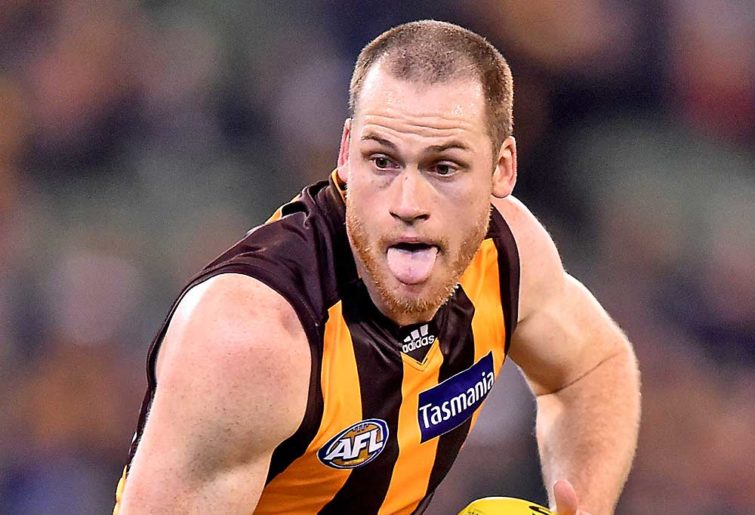
(AAP Image/Joe Castro)
Best 22 of the decade
Back pocket – Ben Stratton
One of the most astute draft selections by the Hawks in living memory. Taken at selection 46 in the 2009 national draft, Stratton quickly cemented himself as a first-choice defender in the Hawthorn team, finishing sixth in the Peter Crimmins Medal in his debut season. A dislocated knee saw him miss majority of the 2011 season, but such was his importance to the side he was rushed back in for Hawthorn’s finals campaign. He played every game in the 2012 and 2013 seasons, picking up his first premiership medal in the latter year. Injury saw Stratton miss ten matches in 2014 but he recovered in time to play in another flag win, a feat he would again achieve a year later as the Hawks went back-to-back-to-back. Ahead of the 2019 season, Stratton was appointed captain of Hawthorn, but it was a controversial year for the courageous defender, who was cited by the match review panel for pinching and stomping on two separate opponents in a game against Essendon. Stratton finished the decade with 189 matches and one goal to his name.
Fullback – Brian Lake
Identifying a need to bring in a strong key defender in order to taste premiership success, Hawthorn targeted Western Bulldogs veteran Brian Lake following their 2012 grand final loss to the Sydney Swans. Lake was acquired in a trade, alongside pick 27, with the Hawks giving up selections 21 and 41. The move paid massive dividends for both parties, with Lake enjoying some of his best football in his time in the brown and gold. He was awarded the Norm Smith Medal for his performance in the 2013 grand final against Fremantle, taking ten grabs and collecting 22 disposals. He was suspended for four weeks in the 2014 season after a controversial incident involving Drew Petrie of North Melbourne, but would return to play a strong role in the Hawks’ grand final win over the Swans. A year later, Lake picked up his third consecutive flag in Hawthorn’s triumph over West Coast, with the 33-year-old deciding to retire after 54 games for the club.
Back pocket – Josh Gibson
Acquired from North Melbourne in a trade at the end of the 2009 season, Gibson had to overcome a torn hamstring in his debut season with the Hawks, but bounced back to finish second in the Peter Crimmins Medal in 2011. He won the award in Hawthorn’s premiership-winning season of 2013, a feat he would achieve again in 2015, highlighting how important he was to one of the greatest teams in the AFL era. In that year of 2015, Gibson was named in the All Australian side for the only time in his career. At the conclusion of the 2017 season, Gibson retired following 160 games, three flags and two best-and-fairests in eight seasons with Hawthorn.
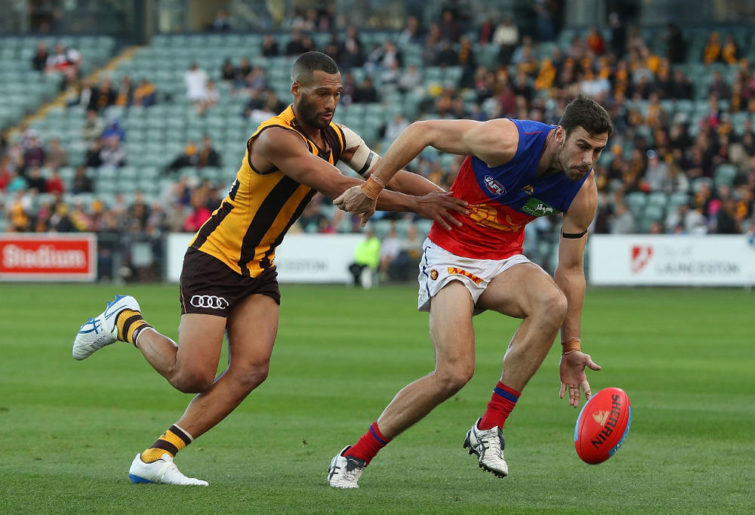
(Photo by Robert Cianflone/Getty Images)
Halfback – Grant Birchall
One of a number of Hawks who played in all four of Hawthorn’s grand final wins under Alastair Clarkson. Birchall was one of Hawthorn’s most consistent performers in the early years of the decade, finishing in the top three of the best-and-fairest in both 2011, 2012 and 2014. In 2012, Birchall was named in the All Australian side for the first time after a brilliant individual campaign. Birchall’s durability was tested late in the decade, enduring an injury-wretched few years. In 2017, he suffered a broken jaw before two separate PCL injuries restricted him to just five games for the year. The same injury would see him miss the entire 2018 campaign, before returning to the Hawthorn line-up to play a handful of games before a hamstring injury in 2019. Birchall then signed with the Brisbane Lions as an unrestricted free agent, concluding his career at Hawthorn after 164 games in the decade.
Centre halfback – James Frawley
Only two years after the Hawks went out and recruited Brian Lake to shore up the back line, Hawthorn went knocking on Melbourne key defender James Frawley’s door in 2014. An All Australian from 2010, Frawley joined the Hawks as a free agent, having immediate success when he played a key role on West Coast forward Josh Kennedy in the 2015 grand final win, keeping him goalless. He would finish in the top ten of the Peter Crimmins Medal a year later, before missing the majority of the 2017 campaign through injury. Frawley has since been a valuable member of the Hawthorn defence as he reaches the twilight of his career.
Halfback – Luke Hodge
The inspirational Hodge started the decade in fine fashion, winning his second club best-and-fairest and earning selection in the All Australian team as captain. Hodge also finished in the top ten of the Brownlow Medal in 2010. He was named the new skipper of the Hawks ahead of the 2011 season, going on to lead his side to three consecutive flags. In 2014, Hodge was named the AFLPA’s best captain, before going on to win the second Norm Smith Medal in his glittering career for his dominant display against Sydney. He stamped himself as one of the best grand final performers a year later, kicking an incredible goal from the boundary in another terrific individual performance on the biggest day of the year. At the end of the 2017 season, Hodge retired after 305 games with Hawthorn, 154 of them coming in the decade.
Wing – Isaac Smith
Smith was Hawthorn’s first pick in the 2010 national draft, gaining the attention of their recruiters after a sensational year playing in the Ballarat Football League and for North Ballarat in the VFL. Since then, he has been a durable member of the Hawthorn midfield, excelling as a line-breaking wingman capable of kicking long goals. He finished in the top ten of the club best-and-fairest in each of Hawthorn’s three premiership years, providing one of the highlight’s of the 2013 decider against Fremantle with a goal from outside 50 that sealed the win. In 2016, Smith had the chance to put Hawthorn through to a preliminary final with a kick after the siren against Geelong, however he missed, with the Hawks ending up being eliminated in straight sets. Following that year, Smith was named co-vice-captain of the club, finishing the decade with 201 games, 161 goals and three premierships for the Hawks.

(AAP Image/Julian Smith)
Centre – Sam Mitchell
One of the game’s most prolific midfielders, Mitchell started the decade as the club captain before handing the reins to Luke Hodge ahead of the 2011 season. With the pressure of leading the club lessened to a degree, Mitchell enjoyed a remarkable few seasons, winning two consecutive best-and-fairest awards in 2011 and 2012, while earning All Australian selection for the first time in 2011, a feat he would repeat in both 2013 and 2015. Mitchell polled a career-high 30 votes in the 2011 Brownlow Medal count, finishing runner-up to Dane Swan. A year later, Mitchell finished equal second in the award to Jobe Watson. The star Hawk played in all three of his side’s flag victories, becoming a four-time premiership player. In 2016, Mitchell won his fifth Peter Crimmins Medal, before Watson was stripped of his 2012 Brownlow due to his role in Essendon’s doping scandal. As a result, Mitchell and Richmond’s Trent Cotchin were retrospectively named that year’s Brownlow Medallists. Mitchell sent shocks through the footballing community at the end of 2016 when he requested a trade to West Coast. He would depart for the Eagles after 152 games and countless accolades in the decade.
Wing – Shaun Burgoyne
After playing 157 games over eight seasons with Port Adelaide following his debut in 2002, Burgoyne surprised the AFL world at the end of 2009 when he requested a trade to play for a Victorian team. Hawthorn won the battle for his services, securing him in a complicated four-way trade. A broken jaw followed by a hamstring injury saw his debut in the brown and gold delayed until Round 8 in the 2010 season, but he surged to the first of an incredible eight consecutive top-ten finishes in the club best-and-fairest. Burgoyne played a crucial role in sending Hawthorn through to the last Saturday in September in 2013, kicking the go-ahead goal in the preliminary final against Geelong. Burgoyne played in all three of Hawthorn’s flags, making him a four-time premiership player. In 2016, he notched up his 300th match. Burgoyne finished the decade with 219 games and 119 goals.
Half forward – Cyril Rioli
Arguably Hawthorn’s most exciting player over the last decade, Rioli enjoyed a breakout season in 2010 with a top-five finish in the Peter Crimmins Medal. His impact up forward continued to grow, kicking 39 goals in the 2012 season and earning selection in the All Australian side for the first time as the Hawks made the grand final. Rioli suffered injuries in the 2013 and 2014 seasons, but in both years he managed to time his run to be fit for Hawthorn’s flag triumphs. In 2015, Rioli was again named as an All Australian before he starred in Hawthorn’s third consecutive premiership, winning the Norm Smith Medal for his 18-disposal, two-goal effort against West Coast. A year later, he booted a career-high 47 majors for the season as he became a three-time All Australian. Rioli suffered a torn PCL in opposite knees in the 2017 and 2018 seasons, restricting him to just a handful of games. Just prior to his 29th birthday, Rioli announced his immediate retirement, citing a wish to return to Darwin to live with his family after 145 matches and 230 goals in the decade.
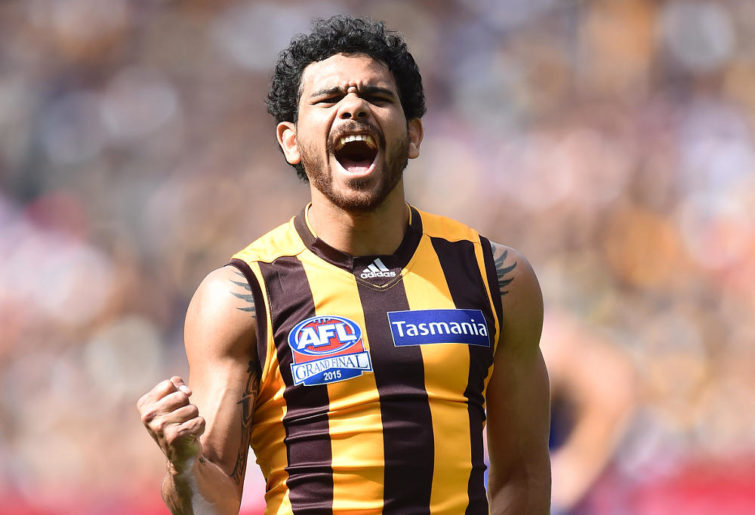
(AAP Image/Julian Smith)
Centre half forward – Lance Franklin
The superstar of the league started the decade with a controversial season in which he was suspended on three separate occasions, however when he did play, his form was back to his absolute best as he kicked 64 goals from just 18 matches, earning himself selection in the All Australian side for the second time and finishing runner-up in the Peter Crimmins Medal. Franklin also won the Goal of the Year award for the first time that year after an unbelievable running goal against Essendon. In 2011, Franklin kicked a remarkable 82 goals, his second highest total in a single season over his entire career. It earned him his second Coleman Medal, while he was again named an All Australian.
In 2012, Franklin played in his first grand final loss as Hawthorn went down to the Swans, but it was another successful season for Buddy, kicking 69 goals and named All Australian for the fourth time. Franklin topped 60 goals yet again a year later as he claimed his second premiership, however it was the first year since 2006 that Franklin didn’t win Hawthorn’s goal-kicking award. Season 2013 also saw Franklin win his second Goal of the Year gong after a mesmerising long goal against Collingwood. After fierce media speculation all season long, and after Hawthorn’s premiership win over Fremantle, Franklin revealed that he would be departing the club after 182 games and 580 goals, with 275 of those goals coming in the decade alone.
Half forward – Jack Gunston
After a promising start to his career playing for the Adelaide Crows, Gunston sought a trade back to Victoria at the end of 2011, citing homesickness. He landed at Hawthorn, enjoying a breakout season in 2012 with 39 goals as he featured in the Hawks’ grand final side against Sydney. Gunston played a key role in Hawthorn’s premiership victory over Fremantle a year later, kicking four goals in a match-winning performance. With Franklin’s departure to the Sydney Swans, Gunston became more of a focal point up forward, kicking 166 goals across the space of three seasons at an average of 55 a year. He led Hawthorn’s goal-kicking in 2015, kicking four goals in the grand final against West Coast as he became a three-time premiership player, while he again won the award in 2016. After struggling with form in 2017, Alastair Clarkson deployed Gunston as a sweeping defender to great effect, however he returned to a permanent forward role in 2018. It resulted in his first selection in the All Australian side after kicking 51 goals for the year. Another year spent playing up the field in 2019 saw Gunston finish the decade with a total of 347 goals from 178 games for the Hawks.
Forward pocket – Paul Puopolo
Looking to add more mature talent to their list, the Hawks went searching the state leagues at the end of 2010, landing on Norwood small defender Puopolo. The 23-year-old debuted in 2011, playing 20 consecutive games, and featuring in Hawthorn’s finals campaign as he was named the club’s best first-year player. In 2012, Puopolo began playing as a primary small forward, kicking 24 goals for the season and playing in Hawthorn’s grand final loss to the Swans. He would go on to feature in all three of Hawthorn’s premiership triumphs, before a career-best season in 2016 in which he kicked 34 goals. Groin and hamstring injuries restricted Puopolo in the 2017 and 2018 campaigns, but he returned to play all 22 games in 2019, giving him a total of 190 matches and 181 goals from the decade.

(Photo by Brett Hemmings/Getty Images)
Full forward – Jarryd Roughead
The popular Roughead started the 2010 decade in a blaze of glory, kicking over 50 goals in a season for the third consecutive year. However, the following year saw Roughead suffer a torn Achilles, seeing him miss the remainder of the 2011 season. He returned early in 2012, kicking over 40 goals as Hawthorn made the grand final, but Roughead struggled as the season went on, kicking just one goal from his last five games, including just three behinds in the premiership decider. Spurred on by the heartbreak of losing to the Swans, Roughead responded with a brilliant 2013 campaign, winning his first Coleman Medal after booting 72 goals. He earned All Australian selection as the Hawks started their three-peat with a win over Fremantle, with Roughead contributing two goals.
Roughead would again be an All Australian the following year, kicking an equal career-high 75 goals as he became the main man in attack for Hawthorn with Lance Franklin leaving. He finished second in the Coleman Medal to Franklin, but would have the last laugh on grand final day, with Roughead booting five majors against the Swans as the Hawks claimed an emphatic 63-point win. Following on from another 50-goal season in 2015, Roughead missed the entire 2016 campaign due to cancer complications, but he made an emotional return to the playing field a year later as the new Hawthorn captain, winning the club goal-kicking award for a third time with 38 majors. After his performance started to fade in the twilight of his career, Roughead was dropped to the VFL in 2019, leading to the 32-year-old announcing his retirement after 181 games in the decade. With 394 goals since 2010, no one at Hawthorn kicked more goals than Roughead across the ten-year period.
Forward pocket – Luke Breust
One man who went awfully close to beating Roughead’s total amount of goals across the decade was Breust, who made his debut in 2011 after being selected in the 2009 rookie draft. With 30 goals in his first season, Breust quickly became a fan favourite, scoring 45 majors in 2012 as the Hawks advanced to the grand final. A year later, Breust became a premiership player following a 40-goal season, but 2014 would be a career-best year for him, earning All Australian selection for his 57 goals, a mammoth total for a small forward. He picked up his second premiership with three goals in the win against Sydney, before becoming a three-time flag-winner the following year against the Eagles in another season in which he topped 50 goals. Breust remained a reliable goal-scorer for Hawthorn as their premiership years became a memory, returning to the All Australian team in 2018 and winning his first club goal-kicking award after booting 54 goals. He again led the goal-kicking tally at the Hawks in 2019 with 39 majors, giving him a total of 392 goals from 207 games in the decade.
Ruckman – Ben McEvoy
Deciding to embark on a rebuild after finishing third-last on the ladder in 2013, St Kilda made a bold decision to trade ruckman McEvoy, with Hawthorn giving up Shane Savage and their first-round draft pick in order to get the deal over the line. After struggling with injury in his first season in the brown and gold, McEvoy made a surprise return to feature in the grand final win over Sydney, in what was his first game in over a month. He would become a two-time premiership player a year later, kicking a goal in the Hawks’ victory over West Coast. In recent years, McEvoy has taken his game to another level, finishing in the top ten of the Peter Crimmins Medal in each of the last three seasons, including a runner-up placing in 2017. Late in the 2019 season, Alastair Clarkson began playing McEvoy in the back line, with the intention of doing the same as footy enters the new decade.
Ruck rover – Jordan Lewis
The gutsy Lewis enjoyed a strong decade with the Hawks, featuring prominently during his side’s dominance over the competition.
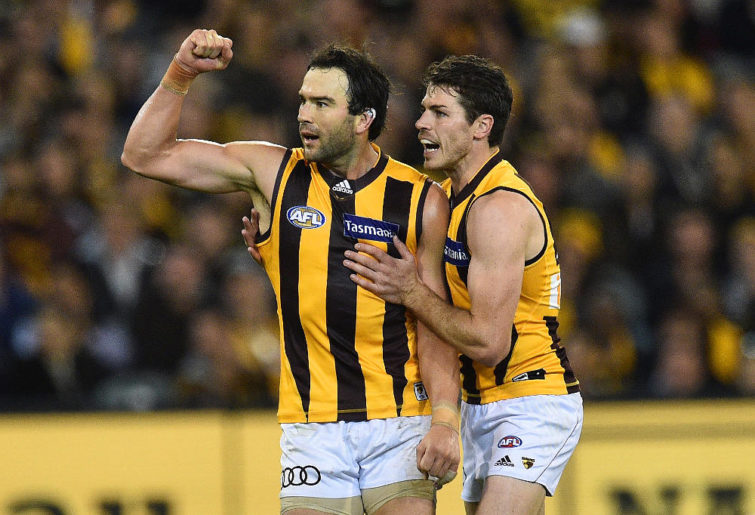
(AAP Image/Julian Smith)
After a top-five finish in the club best-and-fairest in 2010, Lewis won the award for the first time in Hawthorn’s premiership year of 2014 after an incredible campaign that saw him average 27.8 disposals for the year. It resulted in him winning selection in the All Australian team for the first time in his career. Lewis became a four-time flag-winner after the Hawks defeated the Eagles in 2015, before falling just short of claiming another Peter Crimmins Medal in 2016 with a runner-up finish. Incredibly, it would be Lewis’ final year in the brown and gold, with the Hawks trading him to Melbourne as they looked to embrace a younger squad. He finished his time at Hawthorn with 264 games, 162 of them coming in the decade.
Rover – Tom Mitchell
The ball-winning midfielder joined the Hawks from the Sydney Swans at the end of 2016, bolstering a Hawthorn midfield now missing Jordan Lewis and Sam Mitchell. He set a VFL/AFL record in his debut year in the brown and gold, amassing the most disposals by any player across a home-and-away campaign with 787. Mitchell was rewarded with a spot in the All Australian side, while he won his first Peter Crimmins Medal. He achieved those awards again a year later as he smashed his own record for possessions with an incredible 848. After coming runner-up to Dustin Martin in the Brownlow Medal in 2017, Mitchell would become the first Hawk to win the prestigious award since another Mitchell, Sam, in 2012. After a stunning start to his career with Hawthorn, it was put to an untimely halt before the 2019 campaign, suffering a gruesome broken leg at training.
Interchange – Jaeger O’Meara
O’Meara arrived at Waverley Park in the same off-season as Mitchell, seeking a fresh start after missing two full years due to a patella tendon injury suffered with the Gold Coast Suns. After managing just six games in his opening season with the Hawks due to ongoing knee issues, it was deemed a failed trade, but O’Meara bounced back to play a prominent role in the Hawthorn midfield over the past two years. He has finished in the top five of the Peter Crimmins Medal in both 2018 and 2019, helping to fill the void left by the injured Mitchell in the latter campaign.

(Michael Dodge/Getty Images)
Interchange – Liam Shiels
The hard-working Shiels started the decade as a fresh-faced teenager in the Hawthorn line-up, quickly developing into a very reliable player for Alastair Clarkson. Shiels has a breakout year in 2011, playing every game of the season, before featuring in Hawthorn’s losing grand final side a year later. He would become a triple-premiership player in the following years, eventually shouldering a larger load in the midfield with the likes of Sam Mitchell and Jordan Lewis moving on. With the decade over and out, Shiels can look back proudly on his 194 games and 74 goals from the period.
Interchange – David Hale
Another player who crossed over from an opposition club and enjoyed much success with the Hawks. After nine seasons and over 100 games with the Kangaroos, Hale joined Hawthorn at the end of 2010, where he was utilised more as a ruckman who could swing forward. Hale was one of Hawthorn’s best in their grand final loss to Sydney, kicking two goals playing mainly in the ruck. He would taste premiership success in the following years, becoming a three-time flag-winner. Following Hawthorn’s 2015 triumph over West Coast, Hale announced his retirement, having played 108 games and kicking 98 goals for the Hawks.
Interchange – James Sicily
Taken late in the 2013 national draft, Sicily took until 2016 to establish himself in the Hawthorn line-up, but he quickly made up for lost time, booting 30 goals in a breakout season. However it wasn’t long until Sicily was moved to the back line, where he excelled as a rebounding defender capable of cutting off opposition attacks. Known for antagonising the opposition with his up-front style of play, Sicily ended the decade as one of Hawthorn’s best players, having finished in the top ten of the Peter Crimmins Medal in three consecutive years.
Are the Hawks placed better or worse going into the new decade compared to ten years ago?
With all due respect to Alastair Clarkson and the team he has developed after the club’s premiership run in the mid-2010s, the likes of Mitch Lewis, Tim O’Brien and James Worpel don’t quite hold a candle to the likes of Lance Franklin, Jarryd Roughead and Sam Mitchell, who entered the decade in their absolute prime. But with a mastermind of a coach at the helm, anything can be possible for the Hawks, however a push for a 14th flag would appear to be a bit fanciful for the next few years.









































































































